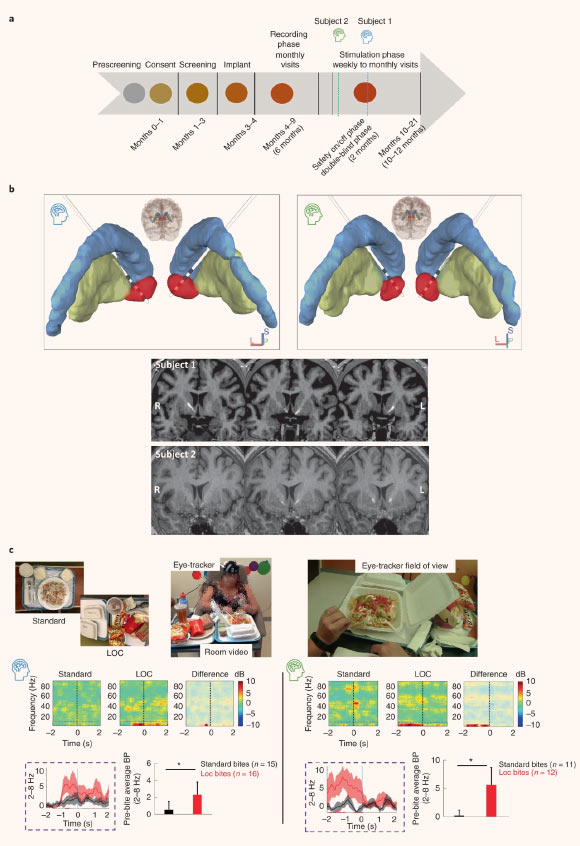In a pilot study led by Pennsylvania Hospital and the Stanford University School of Medicine, deep brain stimulation — guided by patterns of neural activity associated with food cravings — improved self-control of food intake and weight loss in two people with binge-eating disorder and severe obesity.

Characterization of human accumbens electrophysiological signal provoked by exposure to preferred food stimuli: (a) schematic of the multi-stage, staggered enrollment, early feasibility study design; the current stage of each participant within the trial is highlighted (blue – subject 1; green – subject 2); (b) two quadripolar depth electrodes placed bilaterally in the nucleus accumbens; (c) the multi-item buffet of preferred foods allowing us to examine nucleus accumbens electrophysiology during LOC eating as well as the preceding in-lab standardized meals. Image credit: Shivacharan et al., doi: 10.1038/s41591-022-01941-w.
Loss-of-control (LOC) eating, or the subjective sense that one cannot stop eating, is associated with binge eating — defined by the consumption of an objectively large amount of food in a short period of time accompanied by a sense of LOC.
LOC eating is often characterized by the loss of inhibitory control in response to appetitive cues and cravings leading to binge eating.
Recurrent and distressing episodes of binge eating are the key features of binge eating disorder.
Binge eating disorder is the most common eating disorder, affecting up to 3% of U.S. adults, and is the most severe disorder associated with LOC eating based on volume of food consumed. It is associated with obesity, decreased quality of life and premature mortality.
Despite the prevalence and severity of LOC eating, most treatments for obesity fail to address it directly, which limits the efficacy of the most aggressive measures, such as bariatric surgery.
In the new research, Dr. Casey Halpern from Pennsylvania Hospital and Corporal Michael J. Crescenz Veterans Affairs Medical Center and colleagues recorded electrophysiological activity patterns, over a 6-month period, in the ventral and dorsal region of the nucleus accumbens in the brains of two patients diagnosed with binge-eating disorder and severe obesity.
Brain-activity measurements were collected from these patients during periods associated with anticipation of food during standard meals, during food cravings and with LOC eating.
Using these data, the researchers identified a low-frequency brain-activity signature that was specifically associated with food cravings and LOC in both patients.
They then used this newly identified brain biomarker to guide deep brain stimulation of the nucleus accumbens in both patients using a device capable of responsive or closed-loop, deep brain stimulation.
Significant reductions in LOC eating events and subsequent weight loss were observed in both patients after 6 months of brain stimulation.
One of the patients no longer met criteria for binge-eating disorder. No serious adverse side effects were reported.
“The findings provide early support for restoring inhibitory control with electrophysiologically-guided deep brain stimulation,” the authors said.
“Further work with increased sample sizes is required to determine the scalability of this approach.”
The results appear in the journal Nature Medicine.
_____
R.S. Shivacharan et al. Pilot study of responsive nucleus accumbens deep brain stimulation for loss-of-control eating. Nat Med, published online August 29, 2022; doi: 10.1038/s41591-022-01941-w







